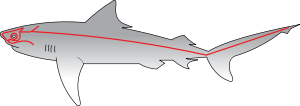Lateral line

The lateral line is a system of sense organs found in fish, and not in land vertebrates. It detects movement and vibration in the surrounding water. Modified epithelial cells, known as hair cells, respond to changes around the fish. These turn the changes into electrical impulses which go to their central nervous system.
Lateral lines are used in schooling, predation, and orientation. For example, fish use their lateral line system to follow the vortices produced by fleeing prey. They are faint lines running lengthwise down each side, from the gill covers to the base of the tail.
In some species, the receptive organs of the lateral line have been modified to function as electroreceptors, which are organs used to detect electrical impulses. Most amphibian larvae and some fully aquatic adult amphibians have systems which work a bit like the lateral line.[1]

